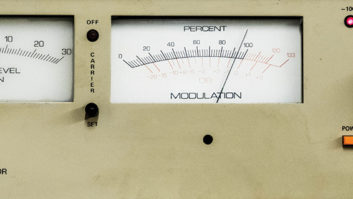The Fungibility Limits of the DAB Ensemble’s Bitstream Are Being Tested in the U.K.
This column has long espoused the need for any new radio service to offer quantitative change – that is, the provision of audio services not available elsewhere – in order to attract listeners.
This premise holds that if a new format offers a purely qualitative improvement to programming already broadcast via other established means, it will be insufficiently compelling to generate broad consumer conversion. This is especially true for FM services, largely considered to be of reasonably high audio quality already.
As digital radio services emerged, this seemingly obvious contention managed to elude many broadcasters and spectrum planners. Today, however, it has begun to slowly dawn on various sectors of the domestic and international radio community.
Yet the delayed acknowledgement of such a fundamental fact is not without penalty, as the latest experience in the United Kingdom is showing.
Eureka, I’ve lost it
The U.K.’s unique success of late with the Eureka-147 DAB format has been widely reported in this space (see our column in the March 28 issue) and elsewhere. The general conclusion of most observers is that the provision of new services by both commercial and public broadcasters on DAB has been a primary (although not exclusive) reason for the format’s new found popularity there.
This repeats the experience of FM’s emergence in the United States, wherein the format languished for decades as a duplicative but higher-quality offering of AM simulcasts, but took off once the FCC mandated the establishment of separate services on the new band.
Given the momentum of DAB receiver sales in the U.K., it stands to reason that broadcasters will want to offer as many new services as possible to optimize listener satisfaction, and to maximize the potential audience of new adopters. When a bandwagon is rolling, “the-more-the-merrier” usually applies. Leveraging the power of a rolling snowball is the simple marketing principle at work here.
Yet in the digital world, there often is a direct tradeoff between quantity and quality of service. The Eureka DAB format is flexibly designed to allow such fungibility of its bitstream, offering broadcasters diverse opportunities to configure each 1.5 MHz-wide “ensemble” of multiplexed services as they see fit, thereby presenting their preferred (and dynamically adjustable) arrangement of audio and data services.
In the interest of standardization, however, there are some limits applied to this flexibility.
Primary among these is the use of only the MPEG-1 Audio Layer 2 codec (MP2) for all audio services – although the bit rate and error protection level used for each MP2 audio service in an ensemble is selectable over a fairly wide range. In a holistic and retrospective view, however, the MP2 codec is intended for “distribution” (i.e., network/headend-to-station transmission) rather than the “emission” (i.e., broadcast) application that DAB actually represents. For this reason, the MP2 codec’s design favors robustness over efficiency.
Nevertheless, for various reasons now relegated to DAB history, the circumstances of timing, and the nuances of standards-setting processes, the MP2 codec was selected and standardized as the sole audio codec for Eureka-147. Subsequent actions by the Eureka consortium (and its successor on the management of this format, the WorldDAB Forum) have strongly reaffirmed this decision.
Therefore, although there are numerous and perhaps more appropriate options for an emission codec available today, Eureka-147 is saddled with the use of a distribution-style codec originally developed almost two decades ago. It was recommended at that time for optimal use in provision of CD-equivalent quality at 224 to 256 kbps. At this rate, and with typical error-protection applied, the 1.5 MHz Eureka ensemble typically could provide five such services, along with program-associated data (PAD) for each. (Capacity would essentially double for monaural services.)
This degree of spectral efficiency approximately equated to that of FM broadcast services (before considering additional, system-wide efficiency provided by the single-frequency network option offered by OFDM transmission). Given the consideration – and many incumbent broadcasters’ preference – that DAB would be a replacement service for AM and FM broadcasts, spectrum planning proceeded with these calculations in mind.
Subsequent learning (courtesy of the George Santayana School of Broadcasting) has shown that such proactive and orderly migration of consumers to new technology does not happen without sufficient motivation – the accommodation of new services being primary among the motivators in this case. Unfortunately, that belated understanding now must be applied to an environment constrained by earlier assumptions.
‘Sweet spot’
For example, the BBC correctly calculated that one national DAB ensemble would be adequate to carry replacement DAB channels for all its existing domestic analog radio services. With the more recent realization that new services are required to make the format broadly successful, the BBC has attempted to squeeze more services into each ensemble. At present, the BBC is running no less than 11 services in a single ensemble, generally at 128 kbps or lower data rates. U.K. commercial radio services generally are doing the same.
Performance of the MP2 codec no longer approaches CD quality for stereo at this data rate – some would argue it is far from it – so the BBC has taken to offering some services in mono, even though some of the content included on these channels is originally produced in stereo. (While most DAB channels are new services, some repurposing or time-shifting of content available in analog is included. In a few cases, the same content available in stereo on BBC’s FM services is presented in mono on DAB.)
As British broadcasters attempt to find the sweet spot at which a balance of quantity and quality can be reached for DAB, they may already have hit the quantitative wall. Complaints about DAB quality in the U.K. are becoming rampant in the trade press and among consumers on Internet discussions. Such negative consumer reaction could curtail the nascent success of the medium there, so the risk of disrupting a fragile new growth trend is high.
Given the resistance to further expansion of service, and the possible need to back off even from current service densities, the viability of DAB operations may need to be recalculated. Yes, the traditional metric of five stereo services per ensemble may be low, but the current U.K. practice of effectively doubling this number is probably too high.
As in many such trials, a pendulum effect may apply, and moderation between these extremes may become the ultimate balance point. Also, consider that improvements in encoder design can always improve the subjective performance of any codec, across its lifespan, typically by around 30 percent. The BBC reportedly is continuing to pursue this option actively.
A two-edged sword
There is another ironic downside to DAB’s use of the MP2 codec.
Its robustness is so high that when other true emission codecs of the day are added as data services to a DAB ensemble, at roughly equivalent error-protection rates, they fail under signal conditions at which the main MP2 audio service continues to perform well. Therefore if a broadcaster opts to provide some rich PAD service using graphics or video, for example, as a user moves away from the transmitter (or into a high-multipath zone), the PAD service would go away while the audio would remain.
Needless to say, as consumers learn to expect such multimedia services, this dissatisfying “monomedia downshift” experience will lead to user complaints, either to the broadcaster or the receiver manufacturer – or both.
Thankfully there is a solution possible to this problem, and the WorldDAB Forum’s Technical Committee is hard at work developing a new optional and backward-compatible error protection layer. For what looks like approximately 8 percent additional overhead, it should be possible to match the error performance of advanced emission codecs with MP2 audio, thereby ensuring that the service areas of MP2 audio and any new services provided by other means will be roughly congruent.
All of this indicates that as the learning curve for DAB continues to twist, broadcasters will need sufficient navigational agility if they expect to ride it to the digital promised land.












